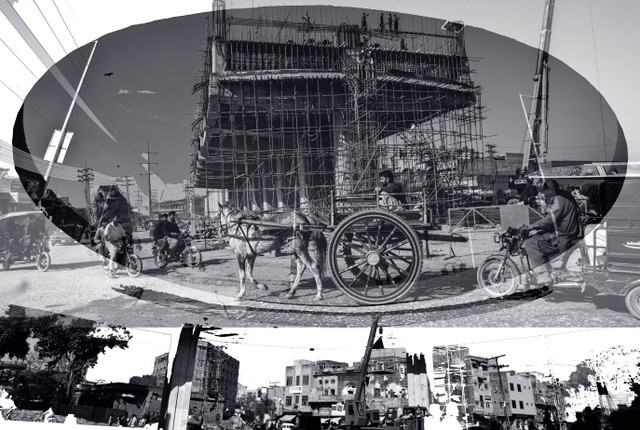
In her recent show at Rohtas 2, Nashmia Haroon introduces a new way of seeing familiar sights or reality

Assumptions, rather fears, about the future of photography as art are as baseless as presuming that availability of pen and paper or computer would make everyone a writer. A smart phone camera does not transform a person into an artist using photography as the means of aesthetic expression.
The difference between an ordinary writer of emails, business contracts, class room exercises, love letters and daily diaries and the writer of literature is not about the tool or process alone. One approaches it as part of daily existence while the other constructs narratives that may be based on life yet escape the ordinariness of life. Similarly, people who are obsessed about clicking on their mobile phone cameras -- either to record a view, moment, incident, gathering or a selfie with besties -- cannot be compared with those who treat photography as a vehicle for creative purpose, for something far beyond actualities.
It is artists like Nashmia Haroon who introduce a new element into reality, rather a new way of seeing familiar sights. In her recent exhibition, the new sights are basically sites which we the citizens of Lahore pass through every day but, like a painful and hazardous experience, tend to ignore. We hope the roads blocked by the jumble of scaffolding, construction material, heavy machinery and deep digging will soon be replaced with a smooth lane or an urban transit system. But as an artist, Haroon, carves beauty amid these unsurpassable and unbearable locations.
In her solo exhibition Unfinished Conversations with Lahore (January12-27, 2018, Rohtas 2, Lahore), using camera as the main tool for image-making, she has constructed works which refer to Lahore, yet these can be about any city being transformed under the illusion of ‘development’.
One is not sure about the genesis of this exhibition’s title (with all sorts of intellectual, incomprehensible and pompously phrased exhibition titles in our art world, I really want to curate a show of exhibition titles only), but the plural in ‘conversations’ relates to her work and mindset. Instead of just one conversation, she prefers to call it a series of dialogues not ending with the show but prolonging in the future (like the never-ending civic work/construction).
Looking at her works on display, one realises it is her formal devices and method of composing imagery (portions of pictures) that lead to the concept of continuous conversations. Two works which consist of clusters of iron pipes covering brick buildings are composed with various views or photographs cut and joined without a linear order. This scheme of image making reinforces her content that is not static, changing and is being a work in progress. The openness of her form adds into her subject, but it also critiques and questions the notion of progress.
Haroon has in the past produced some works about the social and political situations. The new images, even though they seem to be rooted in ‘visual’ transformation of a city, can also be considered comments on the way the social order is being altered by the state. Modification of a city, in the name of welfare and convenience of people, often includes cutting down trees, demolishing small houses of residents belonging to lower middle class and getting rid of footpaths for pedestrians. Thus, development is mainly creating facility for a class that needs roads for its fast-moving vehicles, or a nouveau riche circle that wishes to replicate Lahore into Dubai (with date palms and all). A utopia of sorts.
In her statement Haroon quotes Foucault: "…Utopias are sites with no real places. They are sites that have a general relation of direct or inverted analogy with real/actual scape of society. They present society itself in a perfected former self turned upside down, but in any case these utopias are fundamentally unreal spaces". In her work, actual sites are transmuted into art, into imaginary locations. Just like the authorities’ aim of transforming a real city into an ideal metropolis, she does this in art -- through superimposing various views of a location and creating a new image which, apart from representing the physical area, offers a way of looking at reality.
In our mind’s eye and in our memories, recollections of visual encounters reside in a cluttered mess. Haroon alludes to that state by superimposing pictures on top of each other, thus fabricating a composite vision. This style, echoing the photography-based works of David Hockney from 1982-83, is connected to her subject too. Because the views of interiors of a building or of outside -- of construction material, pipe, iron rods, etc. joined together -- complements the artist’s approach towards her pictorial language.
While one looks at the still photographs from the city displayed in the gallery, one also experiences video installations/projections on walls outside the gallery space. These works installed outside may be a different medium, yet are not separate from collages put within the gallery. Both are connected through her recurring theme but more than that it is the formal approach that links the two bodies of work. As the video pieces are time-based works, her photographs are joined in a manner that view of a site seems to unfold with a (the briefest) passage of time while a viewer is standing in front of these collages.
It appears the city has not only inspired the artist in the selection of her theme, but it has also influenced her way of working. Like ‘work in progress’ signs put on major road blocks in the city, her technique has also turned her art into ‘work in process’, or work in progress.